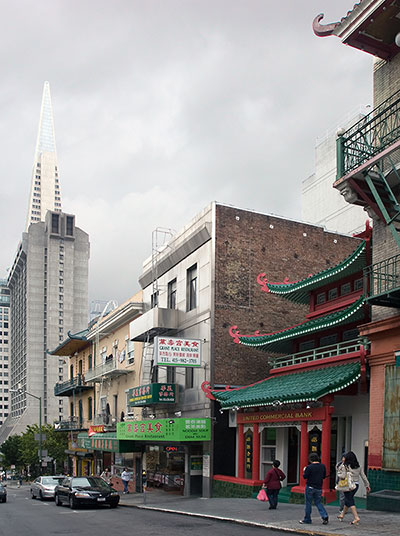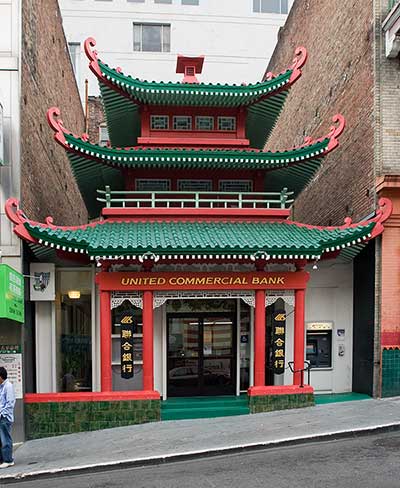California Historical Landmarks in San Francisco
California Historical Landmark 85
Site California Star Newspaper Office
743 Washington Street

25 August 2007
25 August 2007
(Click Photos to Zoom)
On this site January 9, 1847, the first newspaper in San Francisco, The California Star - later known as The Alta Californian, was published by Samuel Brannan with Elbert P. Jones as editor.
Citation from California Office of Historic Preservation

The building which housed the California Star and Daily Alta Californian was either destroyed or demolished prior to 1901. Today's pagoda at 743 Washington Street was built in 1909 as the second Chinese Telephone Exchange building to operate at this address.
The first Chinese Telephone Exchange was built in 1901. The San Francisco Examiner of 17 November 1901 reported:
"The walls are hung with banners in red and yellow and gold. Along one side of the room is a row of teakwood chairs with cushions of silk, while near the switchboard are the small black stools which are to be seen all over the Chinese quarter. The switchboard itself is exactly like those in the other exchanges of the city, except that the operatives are men and Chinese. They used the same cry of "hello" in answer to a call - a pleasant tone, cheerful and good-humored."The work of the exchange would drive an American operator insane. For, in addition to the 255 numbers on the exchange, there are at least 125 telephones which are either in Chinese lodging-houses or in clubs. The operatives have nearly 1500 names to remember, together with their owner's place of residence. For example, Woo Kee rings his telephone and says he wants to talk to Chung Hi Kin. He gives no number, for Chung lives in some big tenement and has no telephone number. It is the duty of the operative [the telephone operator] to remember all these names, and it is claimed he does so without effort.
"The Chinese telephone company was to put in girl operators when the exchange was refitted, and doubtless it will be done eventually. The company prefers women operators for many reasons, chiefly on account of good temper.
"But when the company found that girls would be unobtainable unless they were purchased outright, and that it would be necessary to keep a platoon of armed men to guard them, to say nothing of an official chaperon to look after the proprieties, the idea of girl operators was abandoned."
The first Chinese Telephone Exchange of 1901 was destroyed by the 1906 Earthquake and Fire. The new Chinese Telephone Exchange was opened in 1909 and served as an exchange until 1949 when automated dialing replaced operators and the pagoda was sold to the Bank of Canton.

Points of historical interest associated with Portsmouth Plaza and Gold Rush San Francisco:
- California Star Newspaper Site
- Clay Street Hill Railroad Site
- First American Flag Raised in San Francisco
- First Public School in California
- First United States Branch Mint
- Jackson Square Historic District
- Jenny Lind Theatre and San Francisco City Hall Site
- Montgomery Block Site
- Pony Express Site
- Portsmouth Plaza
- Robert Louis Stevenson Remembrance

